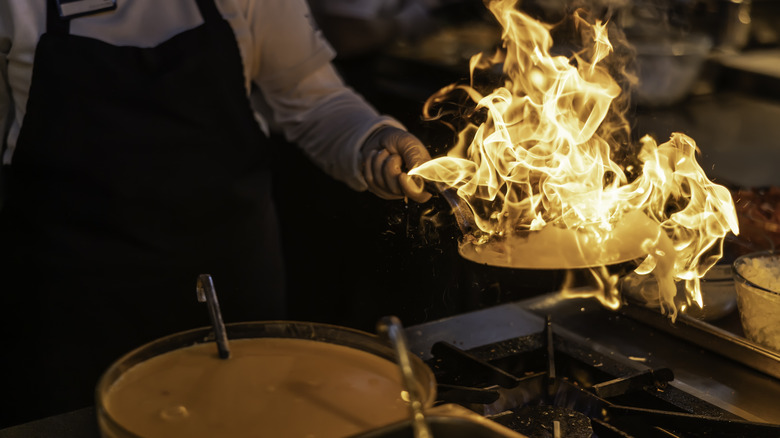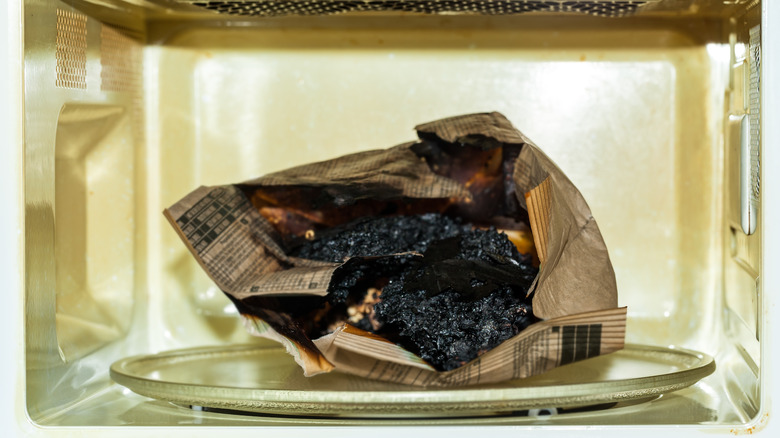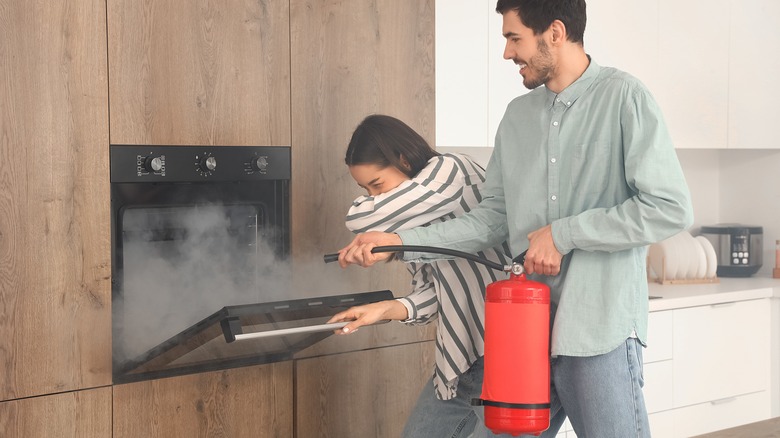Think Twice Before Putting This Flammable Kitchen Waste Item In The Trash
Anyone who cooks knows the agony of accidentally burning food. The smell alone is enough to make you rush to the nearest window and open it. And once the smoke dissipates, you might feel the need to run the food under water or dump it in the trash. In this seemingly logical scenario, what you may not always consider is that certain kitchen ingredients can pose a hidden fire risk. This is especially true for microwave popcorn and other oil-coated, greasy foods.
Part of what caused the food to burn in the first place is that it reached extremely high temperatures, and even after the microwave has stopped, the burning process may still be ongoing. The danger becomes more apparent with microwave popcorn because the packaging is designed to trap heat inside to pop the kernels, which are also coated with cooking oil. Throw the charred popcorn into a trash can with other flammable kitchen waste, and you've created a fire hazard with all the trapped heat, oily residue, and incoming oxygen. Additionally, other burnt foods that might appear harmless can actually contain small embers inside them. That's why it's important to think twice before throwing any burnt food in the trash.
What happens when you throw burnt food items into the trash
You might think tossing burnt food in the trash isn't a big deal, especially if it's no longer burning. But many substances that might look like they have cooled down can still reignite. Charcoal ash is a prime example of that. Burnt food, especially food blackened from overheating, behaves the same way. Inside those charred layers, small embers can survive and flare up again. What makes this a huge problem when thrown away without a second thought is the components already in the trash can itself. Trash cans are rarely ever empty. They are filled with combustible items like paper towels, cardboard, and greasy materials, which are excellent fuel for a fire. Add oxygen to the equation from an open window or a draft, and you now have the full fire triangle: heat, fuel, and air.
With greasy or oil-coated foods like popcorn or brownies, the risk of a fire is even higher. Oil can catch fire much more easily than other substances, and it can spread faster, too. Running the burnt oily food under water before tossing it doesn't eliminate the danger either. Because water is denser than oil, it sinks beneath it, and the heat turns it into steam, causing the oil to splatter or even explode.
Another overlooked hazard can be within the trash can itself. When steam is present, it can react with certain items already in the trash or even the can's material (if it's not fire-rated), like iron and aluminum. These reactions release hydrogen gas, which is another highly flammable substance that will increase the risk of a fire igniting.
Other fire safety considerations
Burning food in the microwave isn't automatically a fire hazard. How you deal with it afterward, however, can make it one. To help protect your home against fires, you need to follow preventative methods and safely dispose of burnt food. When cooking in the microwave, always begin with the lowest recommended settings. If a popcorn package suggests two to three minutes, start with two. Microwaves vary in power, and some can scorch food in as little as two minutes. Never leave the microwave unattended. If you notice smoke, turn it off immediately and keep the door closed until you are certain the fire has stopped. If you're unsure, don't take risks and call 911. And be sure to have an up-to-date fire extinguisher in your kitchen.
Once the smoke clears and you remove the food, if it's still hot, leave it in a sink, on the stove-top, or on a metal tray until it cools completely. You would also want to completely avoid running extremely hot, oily, or greasy food under water. Once the food has cooled, you can then discard it. Finally, the best way to get rid of the burnt smell in your microwave is by ventilating the kitchen and thoroughly cleaning the microwave.


